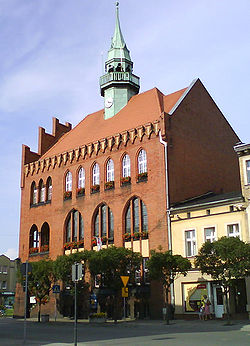Września
| Września | ||
|---|---|---|

Town hall
|
||
|
||
| Coordinates: 52°20′N 17°35′E / 52.333°N 17.583°E | ||
| Country |
|
|
| Voivodeship | Greater Poland | |
| County | Września County | |
| Gmina | Gmina Września | |
| Established | 1256 | |
| Town rights | 1375 | |
| Government | ||
| • Mayor | Tomasz Kałużny | |
| Area | ||
| • Total | 12.73 km2 (4.92 sq mi) | |
| Highest elevation | 110 m (360 ft) | |
| Lowest elevation | 90 m (300 ft) | |
| Population (2006) | ||
| • Total | 28,617 | |
| • Density | 2,200/km2 (5,800/sq mi) | |
| Time zone | CET (UTC+1) | |
| • Summer (DST) | CEST (UTC+2) | |
| Postal code | 62-300 | |
| Area code(s) | +48 61 | |
| Car plates | PWR | |
| Website | http://www.wrzesnia.pl | |
Września [ˈvʐɛɕɲa] (German: Wreschen) is a town in central Poland with 28,600 inhabitants (1995). It is situated in the Września County, Greater Poland Voivodeship (since 1999), previously in Poznań Voivodeship (1975–1998), on the Wrześnica River.
The city was first mentioned in 1256. Early sources speak of Wressna (1317) or Wresna (1364). Września was granted town privileges in the 14th century. The town was burned down 1664 (other sources speak of 1656) in the war against Sweden. The majority of inhabitants were Poles, but since mid-17th century there have also been German settlements. The city was annexed by the Kingdom of Prussia in 1793, following the Second Partition of Poland. In 1807 it became part of the Duchy of Warsaw, but fell back to Prussia in 1815.
Września is known in Poland for a school strike by Polish children in May 1901 in response to the intensification of Germanization (i.e. prohibition of the Polish language at school). The Polish language had long been tolerated in the schools, so the introduction of German as mandatory language led to protests. The controversy led to drawn-out protests between parents and authorities. For refusing to speak German, Polish children were severely beaten by Prussian teachers for several hours. Parents who tried to break into the school and protect their children from Prussian teachers were punished later by a Prussian court stating that their actions were "atrocious acts against the state". The strike spread to neighboring cities and eventually ended in 1904.
In 1905 the town was inhabited by about 7000 people of which 65.4% were Poles, 28.9% Germans and 5.5% Jews. In the surrounding county, Poles comprised 85.6% of the population. The hundred-year-long Prussian rule came to an end with the outbreak of the Wielkopolska Uprising in 1918. In 1920, the city once again became part of Poland. It was around this time that construction of the district office building was completed.
...
Wikipedia


